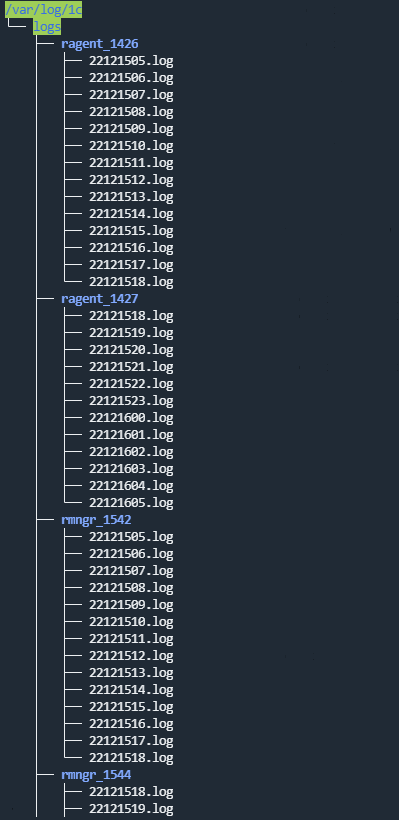Contents
Connector, 1c-log type
Connectors with the 1c-log typeUsed for getting data from 1C technology logs when working with Linux agents. \n is used as the newline character. The connector accepts only the first line from a multi-line event record.
Settings for a connector of the 1c-log type are described in the following tables.
Basic settings tab
Setting |
Description |
|---|---|
Name |
Unique name of the resource. The maximum length of the name is 128 Unicode characters. Required setting. |
Tenant |
The name of the tenant that owns the resource. Required setting. |
Type |
Connector type: 1c-log. Required setting. |
Tags |
Tags for resource search. Optional setting. |
Directory path |
The full path to the directory with the files that you want to interact with, for example, Limitations when using prefixes in file paths Required setting. |
Description |
Description of the resource. The maximum length of the description is 4000 Unicode characters. |
Advanced settings tab
Setting |
Description |
|---|---|
Debug |
Ths switch enables resource logging. The toggle switch is turned off by default. |
Buffer size |
Buffer size in bytes for accumulating events in the RAM of the server before sending them for further processing or storage. The value must be a positive integer. Default buffer size: 1,048,576 bytes (1 MB). Maximum buffer size: 67,108,864 bytes (64 MB). |
File/folder polling mode |
Specifies how the connector rereads files in the directory:
|
Poll interval, ms |
The interval in milliseconds at which the connector rereads files in the directory. Default value: |
Character encoding |
Buffer size in bytes for accumulating events in the RAM of the server before sending them for further processing or storage. The value must be a positive integer. Default buffer size: 1,048,576 bytes (1 MB). Maximum buffer size: 67,108,864 bytes (64 MB). |
Connector operation diagram:
- All 1C technology log files are searched. Log file requirements:
- Files with the LOG extension are created in the log directory (
/var/log/1c/logs/by default) within a subdirectory for each process. - Events are logged to a file for an hour; after that, the next log file is created.
- The file names have the following format: <YY><MM><DD><HH>.log. For example, 22111418.log is a file created in 2022, in the 11th month, on the 14th at 18:00.
- Each event starts with the event time in the following format: <mm>:<ss>.<microseconds>-<duration in microseconds>.
- Files with the LOG extension are created in the log directory (
- The processed files are discarded. Information about processed files is stored in the file /<collector working directory>/1c_log_connector/state.json.
- Processing of the new events starts, and the event time is converted to the RFC3339 format.
- The next file in the queue is processed.
Connector limitations:
- Installation of a collector with a 1c-log connector is not supported in a Windows operating system. To set up transfer of 1C log files for processing by the KUMA collector:
- On the Windows server, grant read access over the network to the folder with the 1C log files.
- On the Linux server, mount the shared folder with the 1C log files on the Windows server (see the list of supported operating systems).
- On the Linux server, install the collector that you want to process 1C log files from the mounted shared folder.
- Only the first line from a multi-line event record is processed.
- The normalizer processes only the following types of events:
- ADMIN
- ATTN
- CALL
- CLSTR
- CONN
- DBMSSQL
- DBMSSQLCONN
- DBV8DBENG
- EXCP
- EXCPCNTX
- HASP
- LEAKS
- LIC
- MEM
- PROC
- SCALL
- SCOM
- SDBL
- SESN
- SINTEG
- SRVC
- TLOCK
- TTIMEOUT
- VRSREQUEST
- VRSRESPONSE
